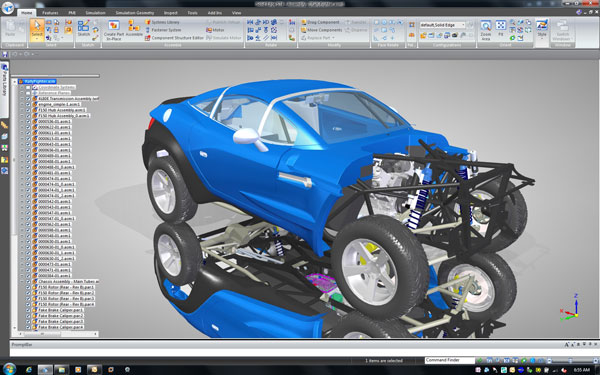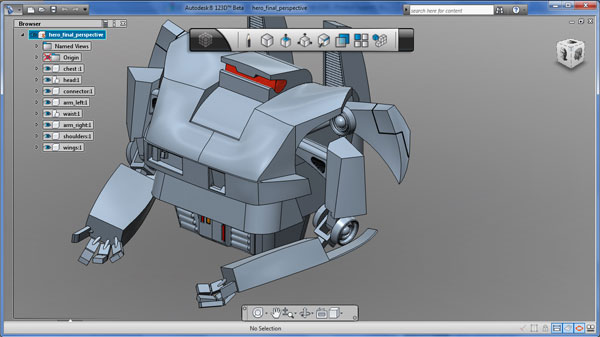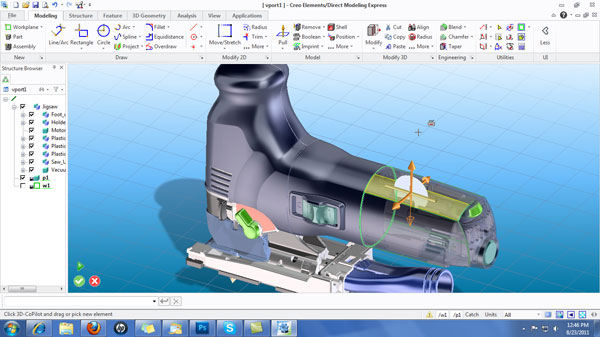Latest News
June 1, 2012
By Kenneth Wong
Affordability is a relative term. A $75 steak that a CEO routinely orders at his or her favorite lunch spot is a luxury reserved for special occasions for a receptionist or a parking attendant. It may even be completely beyond the reach of the latter.
A robust 3D mechanical modeling software program costs somewhere between $3,000 to $6,000—and more if it includes complex operations like surfacing, simulation, analysis and data management modules. This amount is a perfectly reasonable investment for a professional engineer or designer with a steady stream of assignments. But for enthusiasts, amateurs or art students, that’s a big price tag—a significant dip in the budget that may not be justifiable.
Many software vendors seem to have decided to concentrate on their core markets while doing a better job reaching out to potential new customers outside of that core. Their strategies include, among other things, releasing less-costly or free versions of their products, repackaged with cleaner interfaces to appeal to the uninitiated.

Siemens PLM Software launched Design1, a special edition of Solid Edge with Synchronous Technology intended for Local Motors members who can use it to help crowd source designs.
In the last five years or so, a field of low- or no-cost CAD programs has come to market. Some are equipped with enough features for users to produce detailed designs fit for manufacturing. The vendors’ strategy may be to attract new users and build brand loyalty at the point of first contact, but nothing prevents proficient users from taking advantage of the wallet-friendly 3D modelers.
Google SketchUp: A 3D Napkin for Your Concepts
Long before it became Google SketchUp, the general-purpose 3D modeler belonged to @Last Software, headquartered in Boulder, CO. Most 3D modelers in existence at the time were not easy to use; they were difficult by design. The prevalent attitude was that 3D modeling was a sophisticated technology, and average Joes and Janes had no business meddling with it. But SketchUp’s interface, which let users push and pull on faces to create and reshape geometry, proved to be a hit—not just with the professional crowd, but with those who had never used a 3D modeler before. In 2007, SketchUp found a new home at Google after the search giant acquired it. (As press time, Trimble Navigation Ltd. signed an agreement to acquire SketchUp from Google—so the software may soon become Trimble SketchUp instead. See page 8 for details.)
With an installed program directory that takes up less than 70MB, SketchUp is arguably the 3D modeler with the smallest footprint. The compactness makes a difference in how fast it loads, runs and responds to your commands. The software was developed for 3D modeling tasks of all kinds, but it saw swift adoption in architecture before it did elsewhere. Today, SketchUp seems to be the de facto 3D “napkin,” the go-to program for architects looking for a way to quickly model an idea.
That, of course, shouldn’t prevent you from exploring SketchUp for mechanical design.
The software has a series of sketching tools, though not as extensive as the collection you’d find in a professional 3D MCAD program. If you have used 3D MCAD programs, you’ll find that you can use the same approach—sketch a profile, then add volume by extruding the profile—to create your basic shape. If this is your first exposure to 3D modeling (a highly unlikely scenario, since you’re reading a professional engineering magazine), you may find that SketchUp is a good training ground for direct editing—the push-pull modeling paradigm that has made its way into many MCAD packages. The software comes with a collection of basic materials, but they cater primarily to the building industry (roofing materials, carpeting, textile, etc.).
If you’re using the free version of SketchUp, the finished design may be saved as a native SketchUp file or exported as Collada. The Pro version ($495) offers a lot more export options (including 3DS, OBJ, DWG, DXF and VRML formats). Many architecture modelers now have the ability to import SketchUp models.
Support for SketchUp among professional MCAD programs is growing, but not extensive. You may find plug-ins (Sycode’s SKP Import for Inventor, Solid Edge and SolidWorks, for instance) to bring native SketchUp files into other MCAD programs.
123D: Fusion for the Masses
Autodesk’s answer to direct editing was Autodesk Inventor Fusion, a program launched in 2009. With a clean, sparse interface, Inventor Fusion allows you to create geometry from scratch, or edit imported geometry from other MCAD programs using pushing, pulling and rotating faces. Many of Inventor Fusion’s features are migrating to Inventor classic, currently still a parametric CAD package.
123D is derived from Inventor Fusion, intended for novices and beginners. “Autodesk has added features for makers ]the do-it-yourself community and craft makers], allowing for easy fabrication of designs to a 3D printer or laser cutter with the click of a few buttons. So essentially, 123D is not really a truncated version of Fusion, since it has features not available in Fusion,” says Thomas Heermann, Autodesk’s director of product management for Consumer Products.

Cloned from Inventor Fusion’s DNA, Autodesk’s 123D is a free 3D modeler that targets enthusiasts, hobbyists and novices. Its direct links to the 123D online community and 3D printing service providers make the software a good fit for the maker market.
Still, with more than half a gig of program code to run, it’s a full-sized modeler. Most of you are running professional workstations, so the horsepower in your machine should be enough to launch 123D in, well, 1, 2, 3. But the program might test the power of some consumer PCs—the kind beginners will likely pick up from Best Buy.
123D’s modeling window is fully integrated with the 123D community, offering you a way to download and import 3D models others have created and chosen to share. Like a typical CAD program, it gives you tools for 2D sketching, 3D volume creation (including more sophisticated methods like Loft and Sweep), and edge treatments. It also allows you to insert construction planes in 3D space, or create patterned features. The language and the prompts will present no challenge to those familiar with CAD modelers, but it may not be the best for novices still learning the basics of 3D modeling. Robust support for general 3D formats (IGES, STEP, OBJ and even SketchUp files) makes this a great program for opening and editing imported 3D designs.
“Users can save to a wide variety of formats after signing in. Upon doing so, the user can save their files to My Corner—cloud storage that lets the user access their file directly from within other 123D apps,” Heermann notes. “Once users sign in, they can save to VRML, STEP, IGES, DXF, SAT, STL, DWG and SVG ]as well as 123D].”
123D modeling software is part of Autodesk’s 123D initiative, a move to introduce Autodesk products (some repackaged from the professional portfolio, others developed from scratch) to the consumer market. In the last five years, as the do-it-yourself market has grown, propelled by events like the annual Maker Faire, major CAD vendors begin to turn their attention to the same demographics. The thinking is that they can serve the market with a combination of easy-to-use 3D software and 3D printing technology.
Autodesk’s strategy is to release a series of apps, housed under the 123D brand, to enable people with little or no training in 3D modeling to create digital designs—and produce them at rapid prototyping service bureaus or print them in consumer-friendly 3D printers.
Shaping Up with 3DVIA
Dassault Systemes, better known for CATIA and SolidWorks, offers a free downloadable modeling software program dubbed 3DVIA Shape. With all-basic modeling tools (profile sketching, solid volume building, Boolean operations, freeform deformation and more), the software allows you to create basic 3D design concepts with ease.
The drawback, however, is that the software offers no option to save the design to your local hard drive. It’s set up to nudge you toward the online 3DVIA.com community and upload it there.
Exchanging data with other users who don’t use 3DVIA also proves somewhat cumbersome. You’ll have to instruct your collaborator to sign on to 3DVIA.com, the portal where your 3D model is hosted, then download it as 3DXML or Collada format (.DAE extension).
Creo Goes Direct to Enthusiasts
PTC, once known for the all-inclusive CAD-CAM-CAE program Pro/ENGINEER, has started to break up its offerings into smaller chunks of code. Rebranded as Creo apps, the company’s products reappear as Creo Sketch, Creo Parametric, Creo Direct, Creo View, Creo Simulate and the rest. The company has also released a series of free Creo products, including Creo Elements/Direct Modeling Express.

PTC’s direct modeling technology is the foundation of PTC Creo Elements/Direct Modeling Express, a lighter, leaner direct modeler that serves as a good introduction to the technology.
The 180MB download for Creo Elements/Direct Modeling Express gives you access to a simpler, easier version of PTC’s direct modeling technology, repackaged for 3D enthusiasts and beginners. The free version limits you to 60 unique parts in your assemblies; the commercial version, Creo Elements/Direct Modeling, has no limit. In both the free and paid versions, you may import 3D designs as STEP and IGES files, then export them as VRML and STL files. The paid version offers export addition export options, include STEP, IGES, SAT and IDF.
Alibre Design: CAD under $200
Alibre Design, once sold for just slightly less than its competitors (primarily SolidWorks, Solid Edge and Inventor), stunned the CAD market with its dramatic price drop in late 2009—to $99. The special version the company introduced then, dubbed Alibre Personal Edition, is still available today for just a little more than its introductory offer. It now sells for $199.
Alibre was recently acquired by 3D Systems, a leading 3D printer manufacturer, but the new owner seems content, at least for now, to continue to develop and distribute Alibre Design as before.
Whereas many other low-cost CAD packages use direct modeling as their core technology, Alibre Design remains a classic history-based modeler. History has proven that history-based modelers tend to take longer to learn than direct modelers, so if you’re a beginner, you’ll have to invest some time to learn the software. On the other hand, if you’re well versed in history- or feature-based modeling and you simply need a CAD package that costs less, Alibre Design is an attractive option.
To get access to surfacing tools, you’ll need to purchase Alibre Design Professional. Moment of Inspiration (MoI) is a separate installable package for surfacing, and it is bundled with Alibre Design Pro.
Solid Edge by Subscription
Beginning in November 2011, Siemens PLM Software began distributing special editions of Solid Edge with Synchronous Technology, dubbed Design1, through a partnership with Local Motors. For as low as $19.95 per month, Local Motors members may purchase a subscription to Design1, which entitles them to install and use the software on Local Motors projects.
With a strong emphasis on crowd-sourced design, Local Motors lets members post design ideas (mostly automotive design) to the community, solicit design proposals, and fabricate the design at member-accessible manufacturing facilities in several locations. Solid Edge subscriptions for members are available in several tiers, ranging from $19.95 to $299.
The $19.95 subscription gives you export options for Parasolid, IGES, STEP, STL, PDF, u3D, JT and more. It also comes with import options for SolidWorks, Inventor, Pro/E, NX, Parasolid, IGES, STEP, STL, PDF, u3D, JT and more. More complex functions—such as surfacing, finite element analysis (FEA), motion simulation and rendering—are available only in higher-level subscriptions.
More options in 2D
For 2D drawing and drafting, many more options now exist besides AutoCAD and AutoCAD LT. Some of the options—such as Dassault Systemes’ DraftSight, IMSI/Design’s DoubleCAD XT, Siemens PLM Software’s Solid Edge 2D, and PTC’s Creo Sketch—are free. Other options requires a fee, like $795 for Graebert’s ARES Commander. Almost all support the gold standard in 2D drawing: DWG. (For more on this topic, read “Designs Live On and On,” DE May 2012, page 37.)
Pay Attention to the Handshake
Free and low-cost 3D modelers offer beginners, enthusiasts and prosumers (those who are generally more tech-savvy than average consumers, but lack the justification to buy a full-featured professional product at full price) a chance to create their own digital assets in 3D without the cost of professional CAD software. Many of the programs mentioned here use direct-modeling technologies—and for good reason. Direct modelers are generally easier to learn and master than their counterparts in feature- or history-based modeling.
But the real value lies in the programs’ ability to read and write formats commonly supported by professional 3D modelers. Without the ability to exchange data with its higher-end cousins—without the handshake with professional packages—a 3D modeler remains no more than a learning tool.
Kenneth Wong is Desktop Engineering’s resident blogger and senior editor. The list in this article is not an exhaustive study of the low-cost modelers available; it simply represents a collection known to work well (some more than others) with professional-class engineering and design software programs. If you know of other workable software titles not mentioned here, please feel free to drop the author a line at [email protected] or share your thoughts at deskeng.com/facebook.
MORE INFO
Alibre Design
Autodesk 123D
Dassault Systemes
Maker Faire
PTC Creo Elements/Direct Modeling Express
PTC Creo Sketch
Siemens PLM Software
Google SketchUp
Subscribe to our FREE magazine, FREE email newsletters or both!
Latest News
About the Author
Kenneth Wong is Digital Engineering’s resident blogger and senior editor. Email him at [email protected] or share your thoughts on this article at digitaleng.news/facebook.
Follow DE





